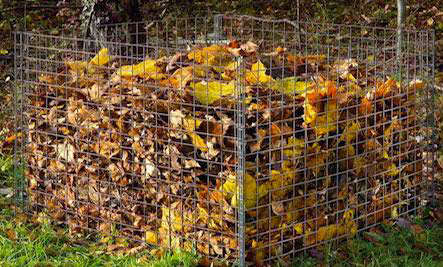Reduce your curbside trips and enrich your garden by composting your fall leaf harvest. Some patience required.
Is this the Fall to consider composting leaves on their own? Leaf Mold (a rather unfortunate name) is compost made solely from decayed leaves. The crumbly result is prized as a soil amendment, particularly for increasing the water retention and nutrients of soil. Because leaves are carbon-based, they do take longer than other plant clippings to break down. The smaller the leaf pieces, the faster they decay. Accordingly, some gardeners shred their leaves with a mower before dumping into their storage spot. The good news is this composting process is best left ignored. Without turning, heating, or additives, the leaves you collect now should be ready for use in your garden next fall. See below for composting container options.
Do you have any tried-and-true composting secrets to share?
Above: Photograph by Justine Hand..

Above: If you have the space, wire compost containers are considered the best bin for the job because of the airflow they provide. After filling the container (best placed in a shady location to prevent leaves from drying out) with leaves, be sure to sprinkle them with water. A Galfan Wire Leaf Composter (Above) is 65€ from Manufactum. For US gardeners, the Bosmere Wire Compost Bin of long-lasting coated steel wire holds up to 15.6 cubic feet of compost; $53.54 through Amazon.
Simple chicken wire compost bins are an easy DIY project (see Sunset’s Chicken Wire Compost Bin Instructions).

Above: Short on space? Another favored method of composting leaves is to fill a basic black plastic garbage bag with the leaves, tie, poke holes in the side to let in air, and ignore for a year. If you need to leave the bags in visible spot, consider an attractive and eco-friendly alternative: a biodegradable jute Leaf Composting Sack that becomes part of the soil conditioner. Once the leaves have decomposed, simply dig the entire bag into the soil; $12.95 for a set of two at Williams-Sonoma. For more options, see our earlier post, Beyond Sack Races: Natural Jute Garden Bags.

Above: Want to accelerate the process such that your leaf compost might be ready to dig into the soil come spring planting time? You can add a natural activator, like the Espoma Compost Starter, to push the process along; $19.99 at Clean Air Gardening. Image via Burgon and Ball.
For rakes, see “High/Low: Steel Leaf Rake.”
NB: For more composting inspiration, see our earlier post: Composting, Indoors or Out.













Have a Question or Comment About This Post?
Join the conversation (1)